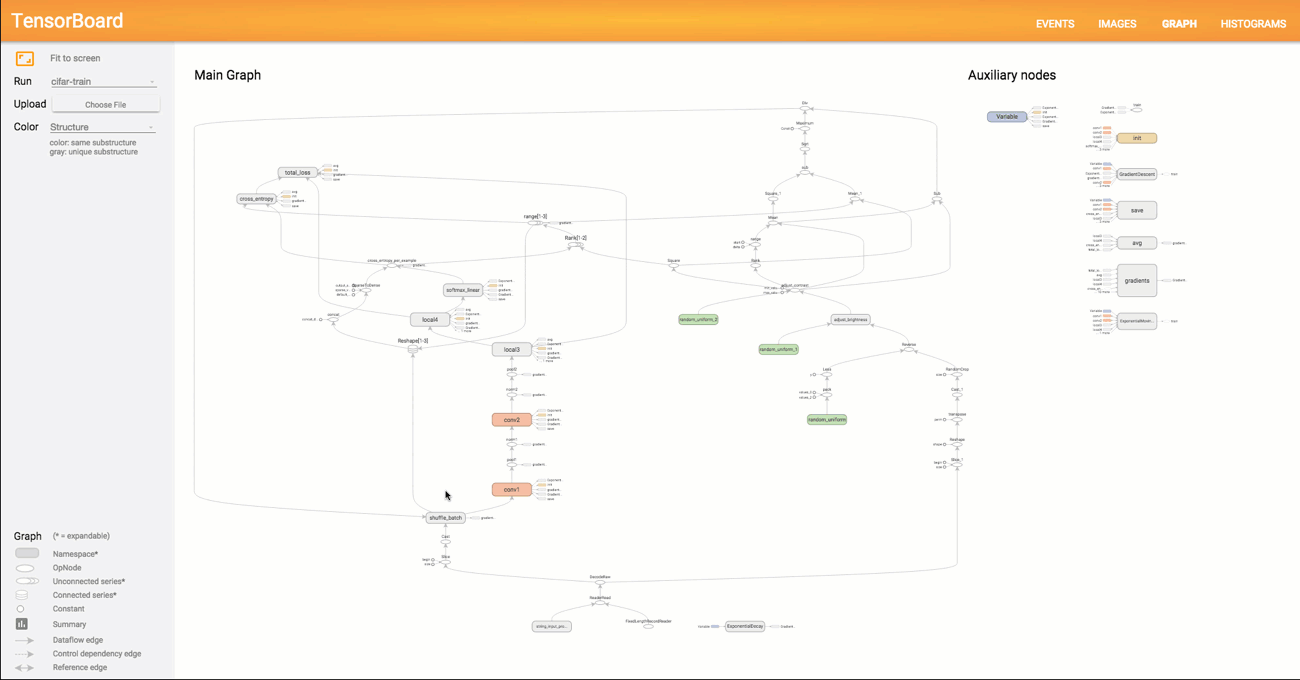Introduction
QuickStart
Installation

因为众所周知的原因,在国内搭建Tensorflow的环境又经历了一些波折。笔者习惯用Docker作为复杂依赖项目的开发环境,Google提供的安装方式有如下几个。
Binary Installation
TensorFlow的Python的API是2.7,最简单的方式就是在MAC或者Unix上使用pip命令导入。
Linux
# For CPU-only version
$ pip install https://storage.googleapis.com/tensorflow/linux/cpu/tensorflow-0.5.0-cp27-none-linux_x86_64.whl
# For GPU-enabled version (only install this version if you have the CUDA sdk installed)
$ pip install https://storage.googleapis.com/tensorflow/linux/gpu/tensorflow-0.5.0-cp27-none-linux_x86_64.whlMac OS X
# Only CPU-version is available at the moment.
$ pip install https://storage.googleapis.com/tensorflow/mac/tensorflow-0.5.0-py2-none-any.whl
Docker
笔者就是用的这个方式,不过可能比较笨吧,之前用的代理下载DockerHub的镜像都没问题,但是死活下不了TensorFlow,只能默默开了个VPS下了镜像然后打包成tar再拖到本地导入,笔者打包的tar文件在这里。导入到本地的Docker镜像库中只需要:
docker load < /tmp/tensorflow.tar具体的Docker的安装过程可以参考笔者的其他文章,镜像下载导入好了之后直接:
docker run -it b.gcr.io/tensorflow/tensorflow这个默认的镜像比较小,只包含了一些必要的运行条件,Google还提供了一个更完整的镜像b.gcr.io/tensorflow/tensorflow-full。
如果需要重新编译的话:
tensorflow/tensorflow
$ docker build -t $USER/tensorflow -f Dockerfile.lite .
tensorflow/tensorflow-full
同样需要依赖于tensor flow的基础镜像,所以还是得翻墙
$ git clone https://github.com/tensorflow/tensorflow
$ docker build -t $USER/tensorflow-full -f Dockerfile.cpu .
这个需要的稍微复杂一点:
$ cp -a /usr/local/cuda .
$ docker build -t $USER/tensorflow-gpu-base -f Dockerfile.gpu_base .
# Flatten the image
$ export TC=$(docker create $USER/tensorflow-gpu-base)
$ docker export $TC | docker import - $USER/tensorflow-gpu-flat
$ docker rm $TC
$ export TC=$(docker create $USER/tensorflow-gpu-flat /bin/bash)
$ docker commit --change='CMD ["/bin/bash"]' --change='ENV CUDA_PATH /usr/local/cuda' --change='ENV LD_LIBRARY_PATH /usr/local/cuda/lib64' --change='WORKDIR /root' $TC $USER/tensorflow-full-gpu
$ docker rm $TC
VirtualEnv
这也是Google官方推荐的一种构建方式,virtualenv是Python领域的一种环境管理,首先是安装所有必备工具:
# On Linux:
$ sudo apt-get install python-pip python-dev python-virtualenv
# On Mac:
$ sudo easy_install pip # If pip is not already installed
$ sudo pip install --upgrade virtualenv其次是创建一个新的工作区间:
$ virtualenv --system-site-packages ~/tensorflow
$ cd ~/tensorflow接下来是启用这个工作区间:
$ source bin/activate # If using bash
$ source bin/activate.csh # If using csh
(tensorflow)$ # Your prompt should change然后在该工作区间中,安装TensorFlow:
(tensorflow)$ pip install --upgrade <$url_to_binary.whl>最后直接运行程序:
(tensorflow)$ python tensorflow/models/image/mnist/convolutional.py
# When you are done using TensorFlow:
(tensorflow)$ deactivate # Deactivate the virtualenv
$ # Your prompt should change backExample
有人在Github上开源了一波TensorFlow的示范教程,大概是这里TensorFlow-Tutorials。
Multiply
import tensorflow as tf
a = tf.placeholder("float") # Create a symbolic variable 'a'
b = tf.placeholder("float") # Create a symbolic variable 'b'
y = tf.mul(a, b) # multiply the symbolic variables
sess = tf.Session() # create a session to evaluate the symbolic expressions
print "%f should equal 2.0" % sess.run(y, feed_dict={a: 1, b: 2}) # eval expressions with parameters for a and b
print "%f should equal 9.0" % sess.run(y, feed_dict={a: 3, b: 3})Linear Regression
import tensorflow as tf
import numpy as np
trX = np.linspace(-1, 1, 101)
trY = 2 * trX + np.random.randn(*trX.shape) * 0.33 # create a y value which is approximately linear but with some random noise
X = tf.placeholder("float") # create symbolic variables
Y = tf.placeholder("float")
def model(X, w):
return tf.mul(X, w) # lr is just X*w so this model line is pretty simple
w = tf.Variable(0.0, name="weights") # create a shared variable (like theano.shared) for the weight matrix
y_model = model(X, w)
cost = (tf.pow(Y-y_model, 2)) # use sqr error for cost function
train_op = tf.train.GradientDescentOptimizer(0.01).minimize(cost) # construct an optimizer to minimize cost and fit line to my data
sess = tf.Session()
init = tf.initialize_all_variables() # you need to initialize variables (in this case just variable W)
sess.run(init)
for i in range(100):
for (x, y) in zip(trX, trY):
sess.run(train_op, feed_dict={X: x, Y: y})
print(sess.run(w)) # something around 2Logistic Regression
import tensorflow as tf
import numpy as np
import input_data
def init_weights(shape):
return tf.Variable(tf.random_normal(shape, stddev=0.01))
def model(X, w):
return tf.matmul(X, w) # notice we use the same model as linear regression, this is because there is a baked in cost function which performs softmax and cross entropy
mnist = input_data.read_data_sets("MNIST_data/", one_hot=True)
trX, trY, teX, teY = mnist.train.images, mnist.train.labels, mnist.test.images, mnist.test.labels
X = tf.placeholder("float", [None, 784]) # create symbolic variables
Y = tf.placeholder("float", [None, 10])
w = init_weights([784, 10]) # like in linear regression, we need a shared variable weight matrix for logistic regression
py_x = model(X, w)
cost = tf.reduce_mean(tf.nn.softmax_cross_entropy_with_logits(py_x, Y)) # compute mean cross entropy (softmax is applied internally)
train_op = tf.train.GradientDescentOptimizer(0.05).minimize(cost) # construct optimizer
predict_op = tf.argmax(py_x, 1) # at predict time, evaluate the argmax of the logistic regression
sess = tf.Session()
init = tf.initialize_all_variables()
sess.run(init)
for i in range(100):
for start, end in zip(range(0, len(trX), 128), range(128, len(trX), 128)):
sess.run(train_op, feed_dict={X: trX[start:end], Y: trY[start:end]})
print i, np.mean(np.argmax(teY, axis=1) ==
sess.run(predict_op, feed_dict={X: teX, Y: teY}))
**粗体** _斜体_ [链接](http://example.com) `代码` - 列表 > 引用。你还可以使用@来通知其他用户。